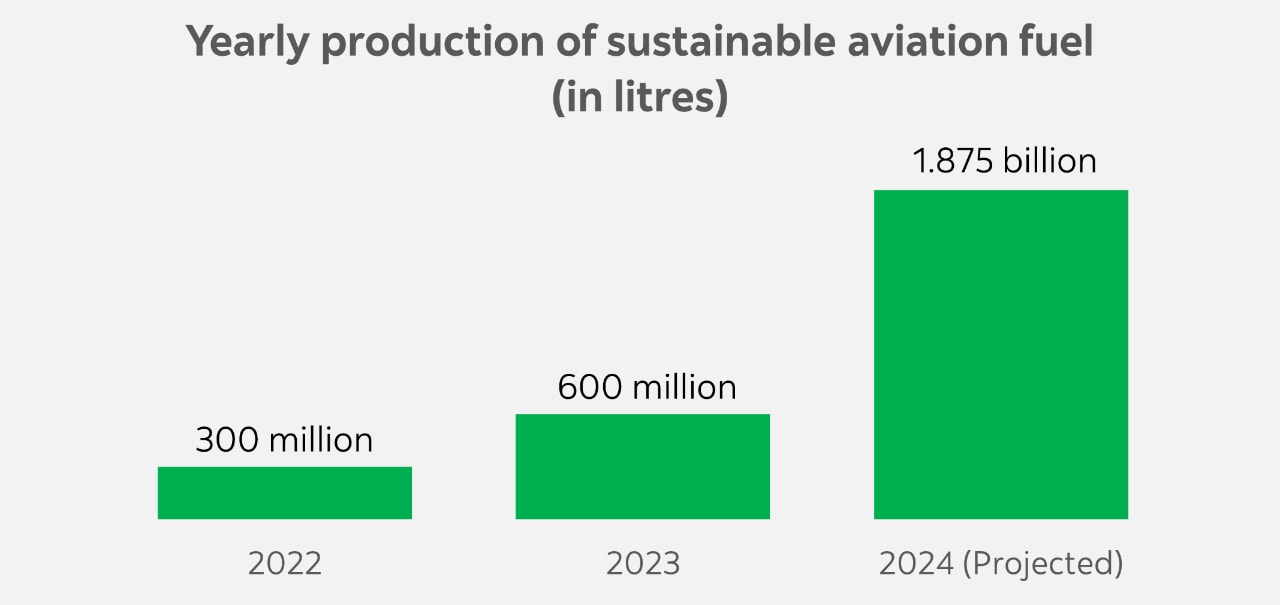Every day, thousands of planes fly around the world to deliver goods and people to their destinations. Meanwhile on the ground below, our global food system generates considerable waste in the form of materials like discarded animal fat, corn stocks and used cooking oil. Behind these seemingly unconnected issues lies a creative solution: sustainable aviation fuel.
Scotiabank recently joined a DHL Express program that enables the Bank to reduce the carbon emissions of courier shipments that are transported using sustainable aviation fuel.
Manufacturers and operators are increasingly testing flights that are entirely fuelled by sustainable aviation fuel, which can be deployed in current infrastructure, engines and aircraft with minor adjustments to fuel delivery equipment. Virgin Atlantic made headlines in November when it completed the first trans-Atlantic flight using 100% sustainable aviation fuel.
To meet the goals for net-zero emissions in the air transport industry by 2050, there are high hopes for sustainable aviation fuel as an immediate “drop-in” alternative to fossil fuels that will significantly cut emissions. While commercial aircraft flights are permitted to use up to 50% sustainable aviation fuel blended with traditional jet fuel, the Virgin Atlantic London-New York flight was a bid to raise awareness and demonstrate the capabilities of sustainable fuels as a complete replacement for traditional fossil fuels.
So, what is sustainable aviation fuel?
Sustainable aviation fuel can result in a reduction in emissions by up to 80% (up to 94% with the right feedstock sources) compared to conventional jet fuel, in addition to benefits like lower particulate emissions and improved air quality. It's an example of a biofuel, which are fuels created from various renewable and waste resources called feedstocks that are readily available everywhere including municipal food and yard waste, unused fats, greases, oils, agricultural residue and much more.
To create biofuels that reduce emissions, feedstocks are collected and transported to a facility where they are mixed and refined into a sustainable fuel. The fuel is then transported to participating airports where it can be blended with traditional petroleum-based diesel.
Roughly 600 million litres of sustainable aviation fuel were produced in 2023, double what was produced in 2022. In 2024, volumes are expected to triple but even with that growth, sustainable aviation fuel will supply less than 1% of the total demand for aviation fuel. Supply and demand for sustainable aviation fuel is expected to grow in coming years, and one projection predicts the fuel will account for 17% of global jet fuel use by 2050.

Source: IATA
Bridging the gap to reduce aviation emissions
Despite the abundance of feedstock in Canada, there is little sustainable aviation fuel produced in the country at present. New projects and investments like a recent federal investment to study and produce the fuel in Manitoba aim to change this.
Unfortunately, sustainable aviation fuel is not yet competing with traditional aviation fuels because of available supply to use and particularly because of cost. Price comparisons vary but sustainable aviation fuel is typically around two to four times as expensive as conventional jet fuel. To drive down costs, producers need capital to invest in additional production capacity. This is what DHL calls its ‘chicken and egg’ problem.
However, if organizations buy into programs that help develop biofuels and governments invest in sustainable aviation infrastructure and incentive programs, it could generate enough momentum to increase supply, lower prices and support demand.
In terms of the current state of policy incentives for sustainable fuels, a report on cleaner-burning fuels by Global Equity Research at Scotiabank found that government incentives vary a lot by jurisdiction, but as a whole, sustainable alternatives to conventional fuel often require incentives to be financially competitive with regular fuel.
While technologies like hydrogen and battery-powered aircraft engines are being explored, sustainable aviation fuel is considered to be a bridge for decarbonization of the aviation sector. By blending sustainable aviation fuel with traditional jet fuel, it means these fuels can be a ‘drop-in’ alternative fuel to cut emissions now because it does not require any engine modifications.

Source: IATA
Scotiabank partnership to reduce emissions
Scotiabank recently entered into an agreement with logistics company DHL to participate in a new program called GoGreen Plus that supports the development and use of sustainable fuel. “We saw this as a great opportunity to progress Scotiabank’s goals to reduce our emissions,” said Alan Cotterill, Scotiabank’s Vendor Management Director.
Cotterill says once his team developed a cost-benefit analysis of the program’s potential impact, it was clear the GoGreen Plus program presented an excellent option to reduce the emissions related to services the Bank purchases. So far, the Bank has reached an agreement with the logistics company to enrol three business units that are among the Bank’s top Canadian users or senders of international packages in the program for outbound international courier shipments originating from Canada. Within the first two months of joining the GoGreen Plus program on Nov. 1, 2023, Scotiabank’s participation has reduced carbon emissions by 3 tonnes.
Looking forward, Cotterill says his team will monitor the success of the agreement with DHL for potential replication across more countries in the Bank’s footprint, and he encourages his colleagues and other organizations to investigate their options for cleaner fuel. “We're also looking at domestic couriers and whether they’re using electric vehicles or not. And it’s an ongoing thing. Once you get one success, you’re encouraged to continue asking, ‘How can we take things to the next level?’” The promising results from the DHL program have encouraged Cotterill to redouble the team’s efforts to find new ways of collaborating with other vendors to reduce emissions.

